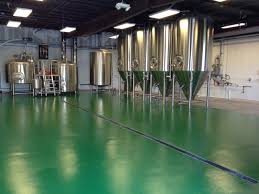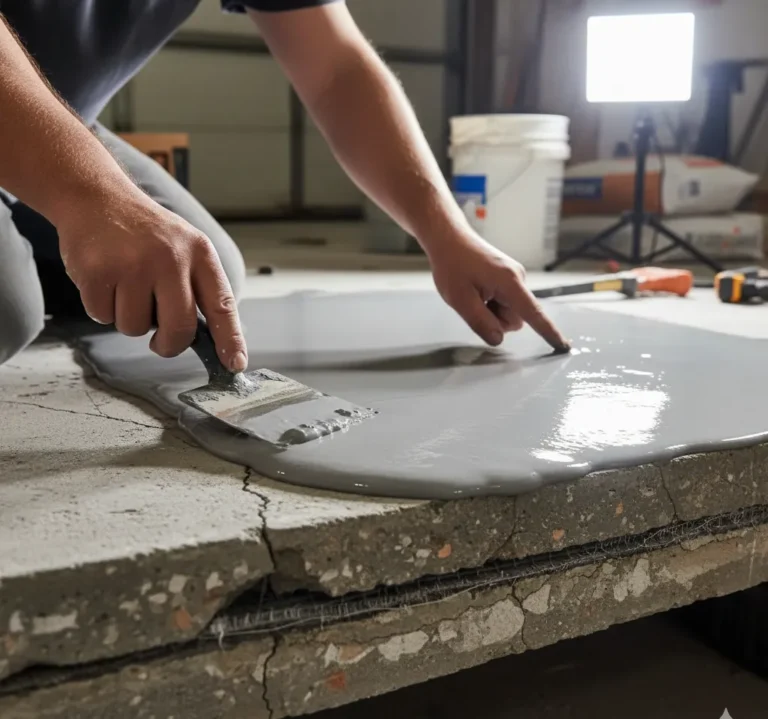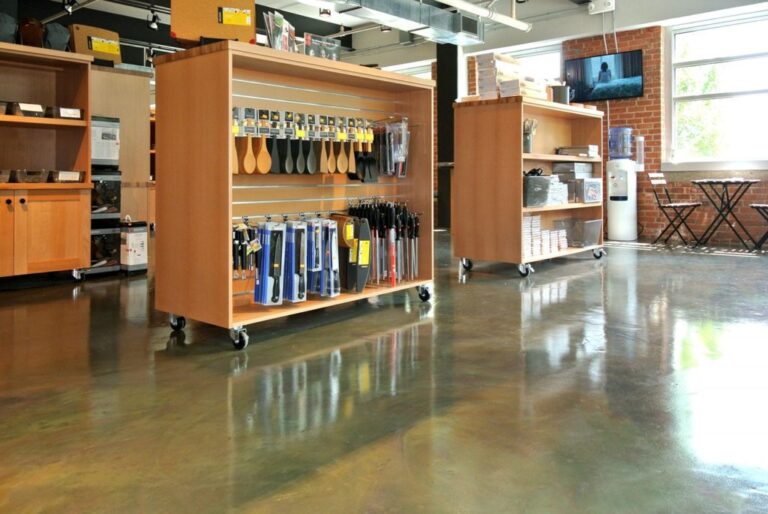Microcement is a cutting-edge, versatile coating material that has revolutionized the construction and interior design industries. This innovative product combines the durability of cement with the aesthetic appeal of modern finishes, offering a seamless and stylish solution for various surfaces.
Definition and Composition
Microcement is a thin, high-performance cement-based coating that can be applied to a wide range of surfaces. It is known for its exceptional strength, flexibility, and aesthetic versatility, making it an increasingly popular choice for both residential and commercial applications.
Key Components of Microcement
The composition of microcement typically includes:
- Fine cement
- Polymers
- Additives
- Pigments
These components work together to create a durable, water-resistant, and customizable surface coating.
- Fine cement: Provides strength and durability
- Polymers: Enhance flexibility and adhesion
- Additives: Improve workability and performance
- Pigments: Allow for a wide range of color options
Uses of Microcement
Microcement’s versatility makes it suitable for a variety of applications across different sectors.
Residential Applications
In homes, microcement is commonly used for:
- Flooring
- Wall coverings
- Bathroom surfaces
- Kitchen countertops
- Decorative elements
Commercial Applications
Commercial spaces benefit from microcement’s durability and aesthetic appeal in:
- Retail stores
- Restaurants
- Hotels
- Office buildings
- Showrooms
Industrial Applications
The robust nature of microcement makes it ideal for industrial settings, such as:
- Warehouses
- Factories
- Laboratories
- Production facilities
| Application Type | Common Uses |
| Residential | Floors, walls, bathrooms, kitchens |
| Commercial | Retail spaces, hospitality, offices |
| Industrial | Warehouses, factories, labs |
Types of Microcement
There are several types of microcement available, each with unique properties and applications.
Bicomponent Microcement
This type consists of two separate components that are mixed before application:
- Cement-based powder
- Liquid resin
Bicomponent microcement offers excellent durability and is suitable for high-traffic areas.
Monocomponent Microcement
A pre-mixed, ready-to-use product that requires only the addition of water. It’s ideal for:
- DIY projects
- Smaller applications
- Areas with less foot traffic
Ready-to-Use Microcement
This type comes pre-mixed and ready for immediate application, offering:
- Convenience
- Consistency in color and texture
- Reduced risk of mixing errors
Epoxy Microcement
A highly durable and chemical-resistant option that combines microcement with epoxy resin. It’s perfect for:
- Industrial settings
- Areas exposed to chemicals
- High-traffic commercial spaces
Tadelakt Aspect Microcement
Inspired by traditional Moroccan plastering techniques, this type offers:
- A unique, luxurious finish
- Water-resistant properties
- Suitability for wet areas like bathrooms and spas
- Bicomponent: High durability, professional application
- Monocomponent: Easy to use, suitable for DIY
- Ready-to-Use: Convenient, consistent results
- Epoxy: Chemical-resistant, industrial-grade
- Tadelakt Aspect: Luxurious finish, water-resistant
Where Can Microcement Be Applied? 
Microcement’s versatility allows for application on various surfaces and in different environments.
- Microcement on Walls
- Microcement Floors
- Microcement Bathrooms
- Microcement in Kitchens
- Microcement Stairs
- Microcement Pools
- Exterior Microcement
Microcement on Walls
Interior Walls
Microcement can transform interior walls, providing:
- A seamless, modern look
- Easy-to-clean surfaces
- Customizable textures and colors
Exterior Walls
For exterior applications, microcement offers:
- Weather resistance
- Durability against environmental factors
- Low maintenance requirements
Microcement Floors
Living Rooms
In living spaces, microcement floors provide:
- A sleek, contemporary appearance
- Durability for high-traffic areas
- Easy maintenance and cleaning
Commercial Spaces
Commercial floors benefit from microcement’s:
- Resistance to wear and tear
- Variety of finishes for different business needs
- Seamless look for large areas
Microcement Bathrooms
Shower Areas
Microcement is ideal for shower areas due to its:
- Water-resistant properties
- Seamless application, reducing grout lines
- Easy-to-clean surface
Bathroom Walls and Floors
For bathroom surfaces, microcement offers:
- Moisture resistance
- Slip-resistant options
- Aesthetic continuity throughout the space
Microcement in Kitchens
Countertops
Microcement countertops provide:
- Heat resistance
- Stain resistance
- Customizable colors and finishes
Backsplashes
For kitchen backsplashes, microcement offers:
- Easy-to-clean surfaces
- Seamless application
- Compatibility with various kitchen styles
Microcement Stairs
Indoor Stairs
Microcement on indoor stairs provides:
- A modern, cohesive look
- Slip-resistant options for safety
- Durability for high-traffic areas
Outdoor Stairs
For exterior stairs, microcement offers:
- Weather resistance
- Low maintenance requirements
- Aesthetic continuity with outdoor spaces
Microcement Pools
Pool Decks
Microcement pool decks provide:
- Slip-resistant surfaces
- UV resistance for color stability
- Seamless, attractive finishes
Pool Interiors
For pool interiors, microcement offers:
- Waterproof properties
- Smooth, comfortable surfaces
- Customizable colors and designs
Exterior Microcement
Patios
Microcement patios benefit from:
- Weather resistance
- Low maintenance requirements
- Seamless integration with indoor spaces
Facades
For building facades, microcement provides:
- Durability against environmental factors
- Modern, sleek appearances
- Customizable textures and colors
- Walls: Interior and exterior applications
- Floors: Residential and commercial spaces
- Bathrooms: Shower areas, walls, and floors
- Kitchens: Countertops and backsplashes
- Stairs: Indoor and outdoor applications
- Pools: Decks and interiors
- Exteriors: Patios and facades
Advantages of Microcement
Microcement offers numerous benefits that make it a popular choice for various applications.
Durability and Resistance
High Resistance to Wear and Tear
Microcement surfaces are known for their:
- Exceptional hardness
- Resistance to impacts and abrasions
- Ability to withstand heavy foot traffic
Long-lasting Performance
The longevity of microcement is attributed to its:
- Resistance to UV rays
- Ability to withstand temperature fluctuations
- Low susceptibility to cracking or chipping
Aesthetic Versatility
Customizable Colors
Microcement offers:
- A wide range of color options
- Ability to create custom shades
- Consistent color throughout the material
Various Finishes
The versatility of microcement allows for:
- Smooth or textured surfaces
- Matte, satin, or glossy finishes
- Unique patterns and designs
Easy Maintenance
Cleaning and Upkeep
Microcement surfaces are easy to maintain due to:
- Seamless application, reducing dirt-trapping joints
- Resistance to stains and chemicals
- Simple cleaning with mild detergents
Repair and Restoration
In case of damage, microcement offers:
- Easy spot repairs without visible patches
- Ability to recoat for a fresh appearance
- Cost-effective restoration compared to full replacement
- Durability: High resistance to wear, long-lasting performance
- Aesthetics: Customizable colors, various finishes
- Maintenance: Easy cleaning, simple repairs
- Versatility: Suitable for multiple applications
- Cost-effectiveness: Long-term value and low maintenance costs
Microcement Finishes 
Microcement offers a range of finishes to suit different aesthetic preferences and functional requirements.
Matte Finish Microcement
Characteristics
Matte finish microcement provides:
- A non-reflective surface
- A natural, understated look
- Subtle texture
Best Uses
This finish is ideal for:
- Modern, minimalist interiors
- Areas where glare reduction is important
- Spaces that require a softer, more subdued appearance
Super Matte Finish Microcement
Characteristics
Super matte finish offers:
- An ultra-flat, non-reflective surface
- A velvety texture
- A contemporary, sophisticated look
Best Uses
This finish is perfect for:
- High-end residential spaces
- Art galleries and museums
- Luxury retail environments
Satin Finish Microcement
Characteristics
Satin finish microcement provides:
- A subtle sheen
- A smooth, silky texture
- A balance between matte and glossy
Best Uses
This versatile finish is suitable for:
- Living areas and bedrooms
- Office spaces
- Hospitality environments
Gloss Finish Microcement
Characteristics
Gloss finish microcement offers:
- A highly reflective surface
- A smooth, polished look
- Enhanced color depth and vibrancy
Best Uses
This finish is ideal for:
- Showrooms and retail spaces
- Modern bathrooms and kitchens
- Areas where light reflection is desired
Non-Slip Matte Finish Microcement
Characteristics
Non-slip matte finish provides:
- Increased traction
- A subtle texture
- Safety without compromising aesthetics
Best Uses
This finish is perfect for:
- Bathroom and shower floors
- Pool decks and surrounds
- Commercial spaces with high foot traffic
| Finish Type | Characteristics | Best Uses |
| Matte | Non-reflective, natural | Modern interiors, glare reduction |
| Super Matte | Ultra-flat, velvety | High-end spaces, galleries |
| Satin | Subtle sheen, silky | Living areas, offices |
| Gloss | Highly reflective, polished | Showrooms, modern bathrooms |
| Non-Slip Matte | Increased traction, textured | Wet areas, high-traffic spaces |
Microcement Colors
Microcement offers a wide range of color options to suit various design preferences and requirements.
Popular Color Options
Microcement is available in numerous colors, including:
- Neutral tones (whites, grays, beiges)
- Earth tones (browns, tans, terracottas)
- Bold colors (blues, greens, reds)
- Metallic shades (silver, gold, copper)
These colors can be used to create various effects, from subtle and understated to bold and dramatic.
Custom Color Matching
One of the significant advantages of microcement is its ability to be custom-colored. This allows for:
- Exact matching to existing color schemes
- Creation of unique, brand-specific colors
- Seamless integration with other design elements
Custom color matching is achieved through: Microcement bathroom elegance brings a smooth and modern look to your bathroom walls and floors It creates a sleek surface that is easy to clean and gives your bathroom a stylish makeover Tile microcement application is a way to make floors and walls smooth and strong It covers old surfaces with a thin layer of special cement that looks modern and stylish
Sleek microcement flooring is a smooth and modern type of floor covering It gives rooms a clean look and is easy to clean and maintain Microcement manufacturers explored Companies that make special cement for thin coatings were looked at Different brands and types of microcement products were checked out
Microcement flooring aesthetics Durable museum surfaces are special materials used in museums that can withstand lots of touching and cleaning without getting damaged These surfaces help protect exhibits and make sure they stay in good condition for a long time Microcement showcases elevate boutique displays by adding a sleek and modern look to store shelves and counters The smooth finish of microcement helps products stand out and catch customers’ eyes
Sleek microcement surfaces are smooth and modern-looking floors or walls They are made by applying a thin layer of special cement that can be polished to create a shiny finish Contemporary kitchen microcement
- Precise pigment mixing
- Color testing and adjustment
- Professional application techniques
- Wide range of standard colors
- Ability to create custom shades
- Consistent color throughout the material
- Options for both subtle and bold color choices
- Possibility of color gradients and multi-tonal effects
High-Performance Microcements: Innovation + Quality
The development of high-performance microcements represents a significant advancement in the industry, combining innovation with superior quality.
Technological Advancements
Recent innovations in microcement technology include:
- Improved polymer formulations for enhanced flexibility
- Advanced additives for increased durability
- Nano-technology for better water resistance
- Eco-friendly options with reduced environmental impact
These advancements have resulted in microcements that offer:
- Greater strength and longevity
- Improved resistance to cracking and chipping
- Enhanced water and stain resistance
- More sustainable and environmentally friendly options
Quality Assurance
High-performance microcements undergo rigorous quality control processes to ensure consistent excellence:
- Strict raw material selection
- Controlled manufacturing processes
- Extensive testing for strength, adhesion, and durability
- Compliance with international standards and certifications
Quality assurance measures include:
- Regular batch testing
- On-site performance evaluations
- Continuous research and development
- Training and certification for applicators
- Advanced formulations for improved performance
- Eco-friendly options available
- Rigorous quality control processes
- Compliance with international standards
- Continuous innovation and improvement
Frequently Asked Questions About Microcement
What is the resistance and hardness of microcement?
Microcement offers exceptional resistance and hardness. It is highly durable and can withstand heavy foot traffic, impacts, and abrasions. The hardness of microcement is comparable to that of traditional concrete, making it suitable for both residential and commercial applications. Its resistance to wear and tear contributes to its long-lasting performance.
Is it necessary to take special care with microcement?
While microcement is durable, some basic care can help maintain its appearance and longevity. Regular cleaning with mild, pH-neutral detergents is recommended. Avoid using harsh chemicals or abrasive cleaning tools. Applying a sealer periodically can enhance its resistance to stains and moisture, especially in high-traffic areas or wet environments.
On what supports can microcement be applied?
Microcement can be applied to a wide range of surfaces, including concrete, cement, tiles, plasterboard, and even wood (with proper preparation). It adheres well to most stable, clean, and dry substrates. However, proper surface preparation is crucial for optimal adhesion and longevity. In some cases, a primer or bonding agent may be necessary to ensure proper adhesion.
Can microcement be applied over radiant floor?
Yes, microcement can be applied over radiant floor heating systems. Its thin application and good thermal conductivity make it an excellent choice for such installations. However, it’s crucial to follow specific guidelines for application over heated floors. This includes ensuring the heating system is properly installed and tested before applying microcement, and following curing times to prevent cracking or other issues.
Is microcement waterproof?
Microcement is highly water-resistant but not inherently waterproof. When properly sealed, it provides excellent protection against water and moisture. For areas with constant water exposure, such as showers or pool surrounds, additional waterproofing measures may be necessary. The application of a high-quality sealer is crucial for enhancing water resistance and preventing water penetration.
Is microcement slip-resistant?
Microcement can be made slip-resistant through various techniques. While standard microcement may not be inherently slip-resistant, additives can be incorporated during application to increase traction. Additionally, specific non-slip finishes are available for areas where slip resistance is crucial, such as bathroom floors or pool decks. The level of slip resistance can be customized to meet specific safety requirements.
What are the differences between microcement and polished concrete?
Microcement and polished concrete are distinct materials with different characteristics. Microcement is a thin coating applied over existing surfaces, offering versatility in application and finish options. Polished concrete involves grinding and polishing the existing concrete floor. Microcement provides more color and texture options, is thinner, and can be applied to various substrates. Polished concrete is limited to existing concrete floors and offers a distinct, industrial look.
How long does a renovation with microcement last?
A well-applied and properly maintained microcement surface can last for many years, typically 10-20 years or more. The longevity depends on factors such as the quality of application, level of traffic, maintenance, and environmental conditions. Regular sealing and proper care can significantly extend the life of a microcement surface. In high-traffic commercial areas, occasional touch-ups or resealing may be necessary to maintain appearance and performance.
Is it necessary to brush the doors?
When applying microcement in a room, it’s not necessary to brush or coat the doors. Microcement is typically applied to floors, walls, and fixed surfaces. Doors and other movable elements are usually left in their original state or finished separately. However, if desired, microcement can be applied to door frames or other fixed elements to create a cohesive look throughout the space.
How to clean the microcement?
Cleaning microcement is straightforward and requires minimal effort. Regular sweeping or vacuuming to remove dust and debris is recommended. For deeper cleaning, use a damp mop with a pH-neutral cleaner. Avoid harsh chemicals, abrasive cleaners, or scrubbing tools that could damage the surface. Spills should be wiped up promptly to prevent staining. In high-traffic areas, more frequent cleaning may be necessary to maintain appearance.
Can microcement lose color over time?
Properly applied and sealed microcement should maintain its color for many years. However, like any surface, it may experience some fading over time, especially in areas exposed to direct sunlight or heavy foot traffic. Using high-quality pigments and UV-resistant sealers can help minimize color loss. Regular maintenance and occasional resealing can help preserve the original color and appearance of the microcement surface.





